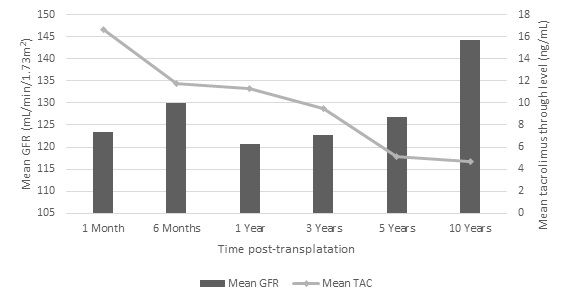Long-Term Outcomes of Renal Function in Pediatric Living Related Intestinal Transplantation.
1Surgery, UIC, Chicago, IL
2Pediatrics, UIC, Chicago, IL
3Surgery, Baylor University, Texas
Meeting: 2017 American Transplant Congress
Abstract number: A266
Keywords: Intestinal transplantation, Pediatric, Renal function
Session Information
Session Name: Poster Session A: Small Bowel: All Topics
Session Type: Poster Session
Date: Saturday, April 29, 2017
Session Time: 5:30pm-7:30pm
 Presentation Time: 5:30pm-7:30pm
Presentation Time: 5:30pm-7:30pm
Location: Hall D1
Background: Renal function after organ transplantation is affected by several factors. The use of calcineurin inhibitors has a direct impact on the kidney. Material and methods: From October 2002 to January 2013, 13 living related small intestinal transplants were performed in 10 children (median age 18 months). Grafts included isolated living related intestinal transplant (n=7), and living related liver and small intestine (n=6). The immunosuppression protocol consisted of induction with thymoglobulin and maintenance therapy with tacrolimus and steroids. Creatinine levels, glomerular filtration rate and tacrolimus levels were measured at baseline, 1 and 6 months post-transplantation, and 1, 3, 5, and 10 years after transplantation. Results: Median baseline GFR was 136.4 (121-275) mL/min/1.73m2. At 1 month, 6 months, 1 year, and 3 years after transplantation, median GFR was reduced to 81%, 81%, 81%, and 87%, respectively.
| Time | Median eGFR | Decreased % of eGFR |
| Baseline (n=10) | 136.4 | 100% |
| 1 month (n=10) | 110.3 | 81% (-19%) |
| 6 months (n=10) | 110.4 | 81% (-19%) |
| 1 year (n=9) | 110.4 | 81% (-19%) |
| 3 years (n=9) | 118.8 | 87% (-13%) |
| 5 years (n=7) | 128.1 | 94% (-6%) |
| 10 years (n=6) | 135.2 | 99% (-1%) |
Meanwhile, at 10 years follow-up, median GFR was reduced just to 99% (135.2 mL/min/1.73m2). Episodes of severe kidney disease, defined as a GFR below 30 mL/min/1.73m2 were also analyzed. Six children presented, at least, 1 episode of severe kidney disease during the follow up. Five children experienced one episode of acute renal failure due to tacrolimus nephrotoxicity, most of the episodes occurred during the first year after transplantation. Conclusion: Kidney disease is a serious complication after organ transplantation that contributes to poor long-term survival rates. Tight control of the calcineurin inhibitors levels in addition to prevention of infections and close control of nephrotoxic medication, may help with the management of this complication.
CITATION INFORMATION: Garcia Aroz S, Czech K, Briar L, Testa G, Benedetti E, John E. Long-Term Outcomes of Renal Function in Pediatric Living Related Intestinal Transplantation. Am J Transplant. 2017;17 (suppl 3).
To cite this abstract in AMA style:
Aroz SGarcia, Czech K, Briar L, Testa G, Benedetti E, John E. Long-Term Outcomes of Renal Function in Pediatric Living Related Intestinal Transplantation. [abstract]. Am J Transplant. 2017; 17 (suppl 3). https://atcmeetingabstracts.com/abstract/long-term-outcomes-of-renal-function-in-pediatric-living-related-intestinal-transplantation/. Accessed December 16, 2025.« Back to 2017 American Transplant Congress
